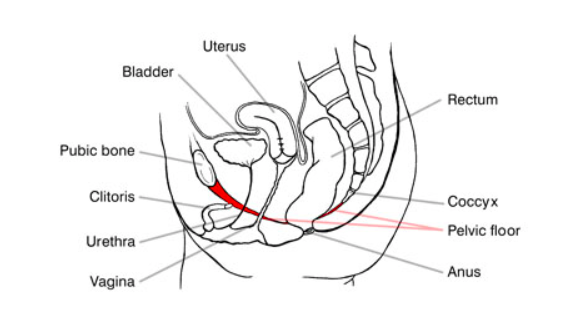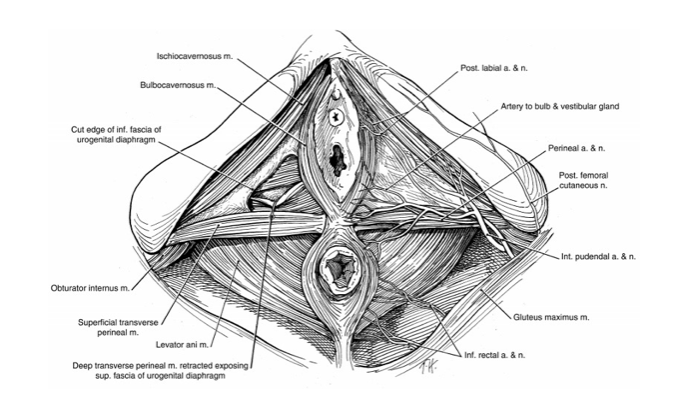We think the female pelvic floor has borderline mystical properties. Get the lowdown on everything women need to know to feel empowered, sexy, and healthy!
“If we are all to sit in a circle and confess our sins, we would laugh at each other for lack of originality.” — Kalil Gibran
The pelvic floor is a very important, sacred piece of a woman’s anatomy. The whole body’s healthy functioning depends on it, including physical, emotional, mental, and hormonal balance.
- Would you like to have good, pain-free SEX? The best sex of your life?? Look to the pelvic floor.
- Would you like to have easier, near symptom free PMS and Menstruation? Look to the pelvic floor.
- Would you like to have a smooth labor and birth, with less trauma and risk? Look to the pelvic floor.
- Would you like to process buried grief, trauma, shame, fear, regret, or other emotional triggers? Look to the pelvic floor!
- Would you like to get rid of spine, hip, leg, or abdominal pain that baffles all the doctors? Look to the pelvic floor!!
- Would you like to have healthy functioning organs, like bladder, uterus, and digestive tract? LOOK TO THE PELVIC FLOOR.
- Would you like to embolden and empower yourself, and embody your life fully, to never question your unique creative power and personal medicine again? LOOK TO THE PELVIC FLOOR!!
The pelvic floor has been a focus for me for many years, maybe an obsession! After very deep work within myself and after some professional trainings, layers and layers emerged, and I have come to know this incredible place as MAGIC.
The Anatomy
There is an intricate balance which is nicely illustrated by this drawing, of the natural alignment of the organs within the female pelvis. They all sit on top of one another, support one another, and are also supported by ligaments and soft tissues, and the layers of the pelvic floor. The angle of the pelvis, how your stand or sit, affects the load on the PF and the bones of the pelvis itself.
Much of our lives are spent in an unnatural posterior pelvic tilt (tucking the tailbone under). This happens almost anytime we sit, and especially if you sit unconsciously, leaning back into the chair or car seat back support. This shortens, and sometimes atrophies the muscles of the PF. As my teacher Leslie Howard says, “We’re a nation of mother tuckers!” This illustration above is, unfortunately, displaying said “tuck.”
Pelvic Diaphragm:
There Are 3 Major Muscle Layers to Make Note of:
Layer #1 – Bulbo Spongeas (Cavernosus): Forms a figure 8 around urethral, vaginal & anal sphincter. Sphincters at rest are contracted.
Layer #2 – Superficial Transverse Perineal: The muscle laterally connecting sitting bones.
(Layer 1 & 2 are undifferentiated at the perineum.) Home of the Root Chakra
Layer #3 – Levator Ani: Like a horseshoe between the pubic symphysis. A group of muscles that “lift the ass.” Attaches to the sacrum, so if it’s tight, it will pull the sacrum out of alignment, which affects the SI joint. Home of the Sacral Chakra.
The Dysfunction
When in neutral alignment, more of the weight of the pelvic organs, and all the organs above them, is shared by the bony structure of the pelvis, specifically the pubic bone, and the pelvic floor muscles. The bones are evolved to support the majority of the weight of the body. However, when our posture fails us, this weight gets distributed entirely to the soft tissues—like the pelvic floor, for example—in a tucked posterior pelvis. This “load” on the tissues creates tension and holding patterns, which can become chronic.
Whenever there is chronic soft tissue tension, there is a resulting weakening. This is exasperated by any loads placed on the muscles while in poor alignment. (Think about the pressures and loads generated by the force of running, or being pregnant, onto various muscles, organs, and connective tissues of the pelvis.)
Weakness comes in two forms, generally. First, weakness from too much tone or tension, which happens more than you would think! Constant tucking shortens the PF muscles, and also requires them to stay firm to support the weight above. Add on the loads of terrible habits like sucking in the belly, bearing down while eliminating, clenching the inner thighs, glutes and all that “down there” and you’ve got yourself a dysfunction called Hypertonicity. This can also be caused by physical pelvic trauma, like a car accident; physical/emotional trauma, like rape; or anxiety, stress and failure to process emotions. (and too many Kiegels!)
Hypertonicity: cannot let go: too much tone.
Symptoms:
- Urge incontinence—have to go NOW! Nervy feeling
- Vulvadinia—pain of vulva
- Vaginismus—vaginal opening shrinks
- Likenschlorosis—skin condition, scarring, autoimmune disease
- Irritable bowel syndrome, constipation/diarrhea
- Systitus—bladder infections, inability to relax
- Painful intercourse
You have to release your hypertension before you can fix anything else.
On the other end of the spectrum, weak PF muscles can also be the product of a lack of tone, or Hypotonicity. This is common for women who are in their postnatal period, as the PF muscles just birthed a baby. As women age, the production of estrogen decreases, and this can cause a lack of muscle tone all over the body, but is especially noted in the PF. Often times finding these muscles to strengthen them is like searching in the dark for a black jelly bean, and can be frustrating for women. There are specific therapies that you can do, movements with very precise muscular targets, and order. Seek out a PF Yoga Therapist or Movement Therapist!
Hypotonic—cannot contract: lack of tone.
Symptoms:
- Stress incontinence—25-45% of women experience this!
- Prolapse of an organ—uterus most common, but bladder and rectum also prolapse.
- Back pain—destabilization of the core and abdomen
- Lack of connection with her creative feminine range
- Flat feet and/or sagging glutes—often indicate lack of tone
- Lack of sensation during intercourse
The Energy
A Note on Mula Bandha:
Mula Bandha is a very slight muscular ‘drawing up’ of the perineum, between a woman’s vagina and anus. I have several problems with the teaching and use of it in mainstream yoga.
- It is an energetic ‘lock’ used in yoga, bringing energy upwards, stimulating the Kundalini to rise. Mula Bandha was originally designed for men’s bodies, but it continues to be taught with this language to everyone, even though the male perineum is at least twice as long as a female’s.
- It was not designed to combine with asana, it was a stand alone practice, performed with skill that took years of practice to master, in seated meditation. K Pattabhi Jois was first to combine Mula Bandha with Asana, and when he was questioned about where he got this methodology and information, apparently the secret book was eaten by mice…
- If Mula Bandha is done by someone who is Hypertonic, there most likely will be serious and continued damage done.
- It’s very difficult to master, even after years of practice, the glutes want to fire, the breath won’t descend back down on inhale, the upward movement of energy isn’t directed or harnessed properly—leaving a lot of spacey yogis ‘all blissed out’ but completely ungrounded.
Needless to say, the energy here in the pelvis is very potent, and has the power to affect the psyche on very deep levels, for better or worse. When properly taught, with correct therapeutic assessment of the state of the PF muscles in the student, Mula Bandha could be a life changing, affirming, empowering and strength-giving practice for the lucky student to receive such instruction. In my opinion, this should only be done with a master practitioner, in a trusting and private setting, with several sessions to build awareness, skill, and strength.
The Female Pelvis Is the Home of the First & Second Chakras
In Eastern traditions, the first and second layers of the pelvic floor are associated with the root chakra, where we tend to literally “hold” fears—specifically, fears around primary instincts such as our health, our family’s safety, and our financial security. It is a “stress container,” in that it’s where we process the emotion and house our fight or flight reactions. You know that feeling when you get cut off by someone while driving, get bad news, or are about to go into a high stress situation? This can cause you to clench your pelvic floor (i.e., it feels like an acid pit in your stomach).
Just above the root chakra, in the third layer of the pelvic floor, is the sacral chakra. This is associated with our sexuality, emotional range, creative sphere and sacred space. The burying of emotions and the lack of self-love eventually leads to a dulling of the sensation here, which can affect everything about how we express ourselves in the upper chakras. Our innate sexual, creative, intuitive and sensitive nature is like a muscle, use it or lose it. This manifests in the physical as pelvic pain, menstruation dysfunction, painful/sensationless sex, endometriosis and more.
There are many great books on the Chakra System, my favorites are the Wheels of Life, and Eastern Body, Western Mind both by Anodea Judith PhD.
Some Solutions
- If you’ve never had your pelvic floor released, consider it. Hunt down an Integrative Structural Specialist, Sexologist, or Internal PF Therapist. This can dramatically improve your connection with your PF on many levels.
- Do some internal work on your own. Internal Pelvic Floor Massage is a beautiful way for you to explore your PF, yourself. Lie down in bed with some lube, and use your fingers, focusing on the lateral wings of your 3rd layer of musculature. Imagine your clitoris as noon, your anus as 6:00 o’clock, and massage up inside the vaginal canal, just interior of the shelf of your bones, from 2-5:00 and 7-10:00 o’clock. Be reverent, respectful, and compassionate to yourself.
- Seek out a Pelvic Floor Yoga Therapist. There is a lot of healing that you can accomplish in private sessions, using asana, breathing techniques, visualizations and meditations, and exercises.
- Check out Abdominal Massage. This is a very old practice, found in indigenous folk medicine all over the planet. The abdomen, belly and pelvis are inextricably connected, and have a wellspring of potential for unlocking your healing capacity. Maya Abdominal Massage, Vedic Thai Yoga Bodywork, Ayurveda, and Chinese Medicine all revere the abdomen as the center of everything.
- Squat More! No, not with weights, or against a wall… the way our ancestors did, and many eastern cultures still do. Spending time in a squat is highly beneficial for the entire digestive/elimination process, as well as very good for creating healthy tone in the PF. Extra credit: get a stool for your feet in your bathroom, so you can squat on the toilet. The Squatty Potty is a great option.
- Don’t tolerate painful sex. If sex is painful, something’s not right. Have a discussion with your partner, do some of these suggestions, figure it out! It continues to relay bad messages to the body and brain when this intimate space is disregarded.
Adore Your Pelvic Floor —Viva la Pelvis!



